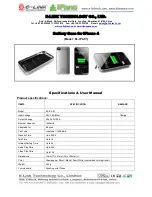
Primary Traffic.
The main traffic stream carried between the mobile station and the base station, supporting the
active promaty service option, on the Traffic Channel. See also Secondary Traffic, Signaling Traffic, and
Servic3e Option.
Private Long Code
. The long code characterized by the private long code mask. See also Long Code.
Private Long Code Mask.
The long code mask used to form the private long code. See also Public Long Code
Mask and Long Code.
Public Long Code.
The long code characterized by the public long code mask.
Public Long Code Mask.
The long code mask used to form the private long code. The mask contains the ESN
of the mobile station. See also Private Long Code Mask and Long Code.
Punctured Code.
An error-correcting code generated from another error-correcting code by deleting (i.e.,
puncturing) code symbols from the code output.
Quick Repeats. Additional transmissions of identical copies of a message within a short interval to increase the
probability that the message is received correctly.
Receive Objective Loudness Rating (ROLR).
A perceptually weighted transducer gain of telephone receivers
relating electrical excitation from a reference generator to sound pressure at the earphone. The receive objective
loudness tating is normally specified in dB relative to one Pascal per millivolt. See IEEE Standard 269-1992,
IEEE Standard 661-1979, CCITT Recommendation P.76, and CCITT Recommendation P.79.
Registration.
The process by which a mobile station identifies its location and parameters to a base station.
Registration Zone
. A collection of one or more base stations treated as a unit when determining whether a
mobile station should perform zone-based registration.
Release
. A process that the mobile station and base station use to inform each other of call disconnect.
The set of all allowable pilot offsets as determined by PILOT_INC, excluding the pilot offsets of the pilots in
the Active Set, Candidate Set, and Neighbor Set. See also Active Set, Candidate Set, and Neighbor Set.
Request. A layer 3 message generated by either the mobile station or the base station to retrieve information, ask
for service, or command an action.
Response.
A layer 3 message generated as a result of another message, typically a request.
Reverse Analog Control (RECC).
The analog control channel used from a mobile station to a base station.
Reverse Analog Voice Channel (RVC).
The analog voice channel used from a mobile station to a base station.
Reverse CDMA Channel.
The CDMA Channel from the mobile station to the base station. From the base
station’s perspective, the Reverse CDMA Channel is the sum of all mobile station transmissions on a CDMA
frequency assignment.
Reverse Traffic Channel.
A Reverse CDMA Channel used to transport user and signaling traffic from a single
mobile station to one or more base stations.
Roamer.
A mobile station operating in a cellular system (or network) other than the one from which service was
subscribed. See also Foreign NID Roamer and Foreign SID Roamer.
ROLR.
See Receive Objective Loudness Rating.
SAT.
See Supervisory Audio Tone.
80
Z3X-BOX.COM
Содержание LG- PX240
Страница 16: ...16 Z 3 X B O X C O M ...
Страница 18: ...18 Z 3 X B O X C O M ...
Страница 21: ...21 Z 3 X B O X C O M ...
Страница 22: ...22 Z 3 X B O X C O M ...
Страница 43: ...Figure 4 3 1 PMIC MAX1827ETL T FUNCTIONAL BLOCK DIAGRAM 4 3 Logic Part Trouble 43 Z 3 X B O X C O M ...
Страница 66: ...Circuit Diagram Figure 4 3 32 LCD 40PIN CONNECTOR Figure 4 3 33 MAIN 60PIN CONNECTOR 66 Z 3 X B O X C O M ...
Страница 86: ...Z 3 X B O X C O M TX RX PX240 ...
Страница 87: ...Z 3 X B O X C O M TX RX Audio MIC Audio Earphone Audio Receiver Speaker PX240 ...
Страница 88: ...Z 3 X B O X C O M PX240 ...
Страница 89: ...Z 3 X B O X C O M Audio MIC Audio Earphone Audio Receiver Speaker PX240 ...
Страница 90: ...Z 3 X B O X C O M PX240 ...
Страница 91: ...Z 3 X B O X C O M PX240 ...
Страница 92: ...Z 3 X B O X C O M PX240 ...
Страница 93: ...Z 3 X B O X C O M ...
















































